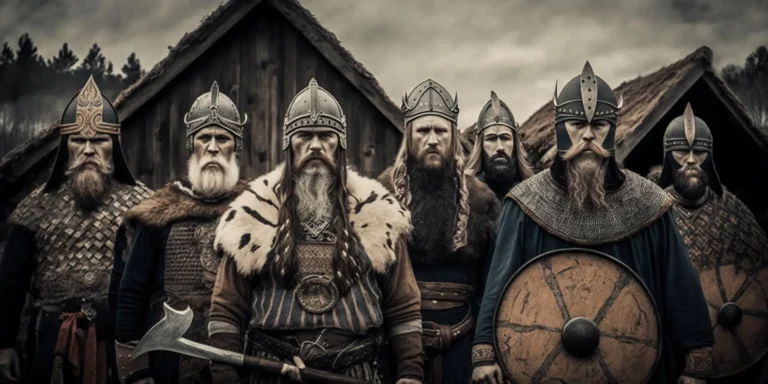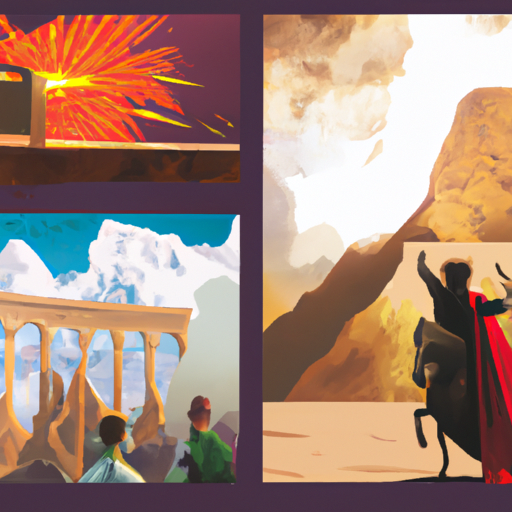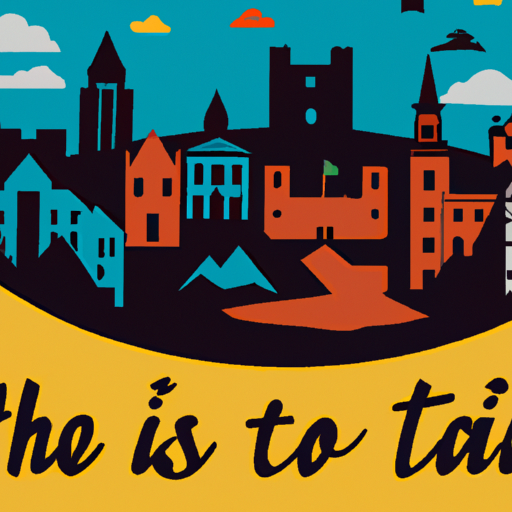A History of the Viking Look: How Did Vikings Dress and Appear?
Unlock a mysterious past and uncover the enigmatic image of these ancient warriors! Delve into the depths of time and explore the secrets of these legendary seafarers. Unearth the truth behind their physical appearance and uncover what they may have looked like. Investigate the clues that remain and unlock the enigma that shrouds them in mystery. Unravel the puzzle and discover how these brave people may have appeared.

Mysterious and enigmatic, the ancient seafaring warriors have long been cloaked in an air of mystery. What did they look like? How did they dress? What tools did they use? To unravel this conundrum, it is necessary to delve into historical records and archaeological evidence to gain a better understanding.
Artifacts such as weapons, tools, clothing, jewelry, and other items can provide clues to their physical appearance. Further insight may be gleaned by examining how they may have used these items or dressed for battle or special occasions. Artistic representations from the period can also offer hints of what they looked like in life.
It is also worth exploring the myths and legends surrounding these warriors to gain further insight into their lives. Many cultures have stories about heroic seafarers who fought against formidable foes on the high seas; often containing details about their physical appearance or dress which could provide additional information about what they might have looked like in real life.
Finally, DNA evidence collected from ancient remains can help build a picture of what these warriors may have looked like in life. By piecing together all these clues from history and archaeology, one can unlock the enigma surrounding these ancient warriors and discover how they appeared long ago.
.
Introduction

A mysterious and formidable people, the Vikings were a seafaring group of Scandinavian warriors who left an indelible mark on history from the 8th to 11th centuries. Renowned for their explorations, commerce, and raids throughout Europe, they had a distinct look that set them apart in battle. Wool or linen garments such as tunics, trousers, cloaks, and hats were typical Viking garb. Facial hair like beards and mustaches was also common. But perhaps their most recognizable feature was their long hair often styled in braids or ponytails and accessorized with metal clips or jewels – a defining characteristic of this remarkable culture.
– Viking History: A Look at the Warriors and Their Impact
The tumultuous, beguiling saga of the Vikings has long enthralled historians and aficionados alike. Their legacy is still felt today, from place names like “Viking” to Norse-inspired artwork on jewelry and clothing. Beowulf is a classic example of literature that features heroic Viking characters battling monsters from ancient folklore tales.
It was in the late 8th century when their seafaring expeditions began, raids on the British Isles, and settlements along the coasts of Europe and beyond. The Viking Age lasted until the 11th century, leaving an indelible mark on European history. They were known for their formidable naval power and fierce warriors who used weapons such as swords, spears, axes, bows and arrows as well as shields made from wood or leather. Mail or scale armour composed of iron or bronze plates sewn onto leather or linen garments provided protection in battle.
In addition to raiding coastal settlements for wealth and resources, they also traded goods such as fur, walrus ivory, weapons, and slaves with other cultures along their routes. The Vikings established colonies in various places throughout Europe including England, Ireland, France, Spain, Italy and even parts of Russia. Tactics such as surprise attacks at night or by sea gave them a tactical edge over their enemies.
Today we can still feel the reverberations of this remarkable period through its influence on language, literature and art styles around the world – revealing its importance to our own lives today.
– Exploring the Physical Appearance of Vikings in History
The ancient Scandinavians, better known as the Vikings, have been a source of fascination for centuries. Their physicality has been an object of curiosity, with many believing that they had fair skin and hair, and stood tall. It was also thought that they often wore animal hides and fur to shield themselves from the cold Nordic climate. Yet, recent archaeological findings indicate that the appearance of these warriors was much more varied than initially assumed. Evidence points to tattoos on their faces and arms, and some even dyed their locks or beards in vivid hues. Moreover, it is possible that those from different regions may have had varying looks due to intermarriage with other cultures. All in all, it appears that the physicality of these legendary people was far more diverse than what was originally believed.
– Uncovering the Clothes and Armor Worn by Vikings in History
Mysteriously shrouded in the mists of time, the Vikings remain an enigmatic people whose violent raids have been seared into our collective memories. Yet, to truly comprehend their culture and lifestyle, one must also consider their clothing and armor. From archaeological evidence, we can determine what they wore and how they protected themselves during battle.
The fabrics used for Viking clothing were wool, linen or animal skins – depending on their wealth and status. Men usually donned a tunic or shirt with trousers or leggings, while women wore long dresses with an overdress and apron. Cloaks were worn by both genders for extra warmth in colder climates, with leather boots reaching up to mid-calf being the usual footwear.
Protective gear was comprised of chainmail – interlocking metal rings that provided protection against swords and other weapons – helmets, shields and greaves (armor for the lower legs). For those more affluent warriors, there were even iron breastplates crafted with immense difficulty; these items were incredibly expensive at the time.
Thus, by examining Viking history we can gain insight into their culture and lifestyle through understanding their clothes and armor.
– Examining Viking Hairstyles and Facial Hair Throughout History
For centuries, the unique and daring fashion choices of the Vikings have captivated onlookers. From their long, flowing tresses to their intricate braids and beards, these iconic hairstyles and facial hair were a central part of Viking culture and identity. Exploring the varied styles of Viking hairstyles and facial hair throughout history can offer us insight into this ancient civilization.
In the early days of Viking culture, men typically wore their hair long with a center part; often braided or tied back in a ponytail. Beards were also popular among men during this time period, groomed and adorned with metal rings or beads. Women usually kept their hair loose or in two braids that hung down either side of their face.
As time progressed, so did the styles, becoming more elaborate as they entered the Middle Ages. Men’s facial hair was still worn but much shorter than before, while women’s hairstyles featured multiple braids or twists held together by decorative pins or combs made from metal or bone. By the late Viking era, these ornate hairdos included intricate braiding patterns that extended down the back of the head and around the face; men’s facial hair once again grew longer but was kept neat by using bear fat oils for sheen. Women continued to sport multiple braids but now often decorated with feathers or flowers woven into them for extra flair.
Today, modern renditions of these traditional Viking hairstyles can be seen at festivals across Europe as people continue to embrace this unique cultural tradition from centuries ago. Through examining Viking hairstyles and facial hair throughout history we can gain a better understanding of this captivating culture that has left its mark on our world today.
– Investigating Viking Artifacts to Understand Their Look in History
Exploring the mysterious depths of Viking culture can be a captivating journey. By delving into the artifacts they left behind, we can begin to unravel the secrets of their past. From pieces of jewelry to weapons and clothing, these items provide us with a glimpse into their lives and beliefs. Additionally, archaeological excavation sites offer an even more detailed look at what life was like for the Vikings, offering up evidence of tools used for farming or fishing, weapons used in battle or hunting, and jewelry worn by women. Coupled with scientific methods such as carbon dating, these artifacts allow us to gain a better understanding of the timeline of Viking history and how it has changed over time. Thus, through this research we can form a vivid picture of what life looked like in Viking history.
conclusion

A multifarious population, the Vikings boasted a broad spectrum of physical traits – from tresses to irises, to hues of epidermis. Antiquated documents suggest that an abundance of Norsemen had fair or rufous manes, azure eyes, and pallid skin. Nevertheless, it is plausible that an extensive variety in the visage of Vikings existed over their timeline.
.
Some questions with answers
Q1. What did Vikings look like?
A1. Vikings were typically tall and strong, with light-colored hair and eyes. They often wore long braids, as well as facial hair.
Q2. What type of clothing did the Vikings wear?
A2. The Vikings wore a variety of clothing depending on the season and occasion. Most commonly, they wore wool or linen tunics and trousers, with cloaks for warmth in cold weather.
Q3. Did Viking men wear jewelry?
A3. Yes, Viking men often wore jewelry such as necklaces, arm rings, and brooches to show their status or wealth.
Q4. Did Viking women wear makeup?
A4. Yes, Viking women often used natural ingredients to create makeup such as kohl eyeliner and lip balm made from beeswax.
Q5. How do we know what the Vikings looked like?
A5. We know what the Vikings looked like through archaeological evidence such as artifacts, paintings, and written accounts from other cultures that interacted with them during their history.




